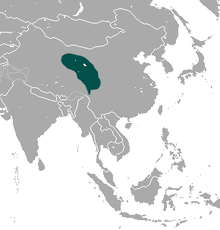Red-eared pika
| Red-eared pika | ||||||||||||
|---|---|---|---|---|---|---|---|---|---|---|---|---|
| Systematics | ||||||||||||
|
||||||||||||
| Scientific name | ||||||||||||
| Ochotona erythrotis | ||||||||||||
| ( Büchner , 1890) |
The Rotohr pika or Chinese Red Pika ( Ochotona erythrotis ) is a mammal of the family of pikas inside the lagomorphs . Its distribution area is limited to the highlands of the Chinese provinces of Gansu , Qinghai , Sichuan , Xinjiang and Yunnan .
features
The red-eared pika is a comparatively large pika. It reaches a body length of 18.1 to 28.5 centimeters and resembles various other species of the genus Ochotona both in its body size and in the main features of the skull. He has a light, rust-brown summer coat, which is gray-red-brown in the chest area of some individuals. The chest is also reddish brown, the belly white. In winter the species is dark or pale gray on the back and belly, but the ears keep their reddish brown color. Further differences to other species, especially Ochotona rutila and Ochotona gloveri , exist in the skull morphology.
distribution
The distribution area of the red-eared pika is limited to the highlands of the Chinese provinces of Gansu , Qinghai , Sichuan , Xinjiang and Yunnan .
The red-eared pika lives in alpine meadows or scrubland on rock walls and ledges at altitudes between 2000 and 4000 meters.
Way of life
Very little information is available about the way of life of this pika. He digs simple structures with lengths of one to two meters. The reproduction period is from May to August. The females give birth to young animals once or twice a year, with a litter consisting of three to seven young.
Systematics
The red- eared pika was previously regarded as conspecific with Ochotona rutila , at times, on the other hand, Ochotona gloveri and Ochotona brookei (now O. gloveri brokkeri ) were added to Ochotona erythrotis , mainly due to their proximity . The differentiation between the species O. erythrotis , O. gloveri and O. rutila is based primarily on the different coat color and on the differences in skull morphology.
Hazard and protection
The species is classified as not endangered (least concern) by the International Union for Conservation of Nature and Natural Resources (IUCN) due to the presumably large population and the large distribution area. Although there are no specific data on the size of the population, it is assumed that the population is at least not declining so strongly that a hazard could be derived from it.
supporting documents
- ↑ a b c d e Joseph A. Chapman, John EC Flux (Ed.): Rabbits, Hares and Pikas. Status Survey and Conservation Action Plan. (PDF; 11.3 MB) International Union for Conservation of Nature and Natural Resources (IUCN), Gland 1990; Pp. 30-31. ISBN 2-8317-0019-1 .
- ↑ a b c d e f Ochotona erythrotis in the endangered species Red List of IUCN 2011. Submitted By: AT Smith, CH Johnston, 2008. Retrieved on 10 February 2012 found.
literature
- Joseph A. Chapman, John EC Flux (Eds.): Rabbits, Hares and Pikas. Status Survey and Conservation Action Plan. (PDF; 11.3 MB) International Union for Conservation of Nature and Natural Resources (IUCN), Gland 1990; Pp. 30-31. ISBN 2-8317-0019-1 .
Web links
- Ochotona erythrotis in the endangered Red List species the IUCN 2011. Posted by: AT Smith, CH Johnston, 2008. Accessed on February 10 2012th
